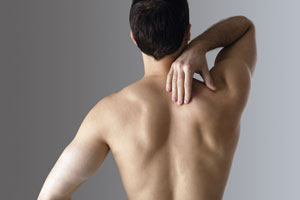Straight Back Syndrome: Case Study Shows How Chiropractic Helped
 A new case study demonstrates how chiropractic care can ease symptoms of straight back syndrome (SBS).
A new case study demonstrates how chiropractic care can ease symptoms of straight back syndrome (SBS).
SBS is a deformity characterized by a loss of the normal curvature of the upper back, or thoracic spine. The deformity reduces the diameter of the chest, compressing the heart and great vessels, pushing the hearts towards the left.
Patients often present with cardiac murmurs, chest pain, tracheal compression, and mitral valve prolepse. Although the condition has been recognized for over 50 years, the overall prevalence of SBS is unknown due to possible underdiagnosis.
Case Study on Straight Back Syndrome
Paul M. Gold, BSc(H), DC, and colleagues recently published a case study illustrating how chiropractors can diagnosis and treat SBS. A 38 year-old man presented at a chiropractic clinic with moderate chest pain and tightness on his left side; tingling/numbness in his left arm; significant mid-thoracic pain; shortness of breath; and chronic fatigue. The man had already undergone a number of diagnostic tests including blood work, ECG, cardiac stress test, and echocardiography, but had produced normal results. He was diagnosed with "thoracic strain", prescribed Naproxen, physiotherapy, and massage therapy. After six weeks, none of the interventions appear to be working.
At the start of his chiropractic care, the man received a physical examination, x-rays, and orthopedic testing which eventually led to the diagnosis of chronic straight back syndrome. Chiropractors treated the patient with a combination of electrical stimulation, spinal adjustments two to three times per week for 18 sessions, and exercise rehabilitation. Within six weeks, the patient's pain scores had decreased from an 8 to a 2, and his disability scores had dropped from a 12 to 1. He had no chest pain and significantly reduced thoracic stiffness. Although his arm symptoms were less frequent ( down to twice monthly from daily), the patient continued to have tightness in his upper trapezius muscle, requiring additional thoracic spinal adjustments. At both the six month follow-up visit and the 23 month re-examination, the patient continued to have no chest tightness and pain or shortness of breath.
"As successfully shown in this case study, patients with SBS may not require any form of invasive treatment and often benefit from conservative care for symptomatic relief," Gold and his colleagues concluded. They recommended that when treating patients with SBS, chiropractors first rule out cardiogenic causes through medical reference. Then SBS patients may find relief with a combination of chiropractic adjustments, soft tissue treatments, and active exercise.
Chiropractic care may also benefit patients with other rare spinal conditions such as Scheuermann's kyphosis.
Reference
Gold P, et al. Straight Back Syndrome: positive response to spinal manipulation and adjunctive therapy -A case report. Journal of the Canadian Chiropractic Association 2013; 57(2): 143-149.



